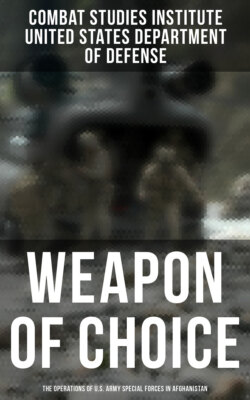Читать книгу Weapon of Choice: The Operations of U.S. Army Special Forces in Afghanistan - Combat Studies Institute - Страница 34
На сайте Литреса книга снята с продажи.
JSOTF-North Growing Pains at K2
ОглавлениеAnother problem 5th SFG faced as the JSOTF was the influx of units ordered into theater without their corresponding headquarters. For example, both CA and PSYOP units arrived and reported to the JSOTF. By doctrine, however, a joint civil-military operations task force would normally command CA units, and a joint PSYOP task force would command PSYOP units. A JTF usually would command both. However, none of these commands had been established in the Afghanistan theater. Although those units were invaluable in conducting the campaign, directing them placed an additional burden on an already overburdened staff.
Within the JSOTF, COL Mulholland soon recognized that he was short the expertise to coordinate fire support and to plan aviation operations. LTC Richards borrowed a captain and staff sergeant from the 10th Mountain Division to plan fire support. He implored the Air Force 16th Special Operations Wing (SOW) to provide someone to assist in planning fixed-wing aviation missions and a planner from the 160th SOAR for rotary-wing operations. The problem of liaison and planning was solved when the Joint Special Operations Air Component (JSOAC) collocated with the JSOTF.
The staff was also saddled with base operations functions—sanitation, billeting, feeding, and security. Eventually, about 40 individuals were added to the 5th SFG staff to assist in accomplishing all its assigned missions. Many of those soldiers came from the 20th SFG—an ARNG group.
LTC Walters departed the JSOTF headquarters in mid-November, and LTC Richards left in December. Because of the professionalism and dedication of the 5th SFG soldiers and the assistance of the SOCJFCOM training team, by then, the JSOTF was performing its assigned responsibilities admirably. This is due in no small measure to the professionalism of all involved. Nevertheless, there were areas identified that needed to be resolved. Among those areas was determining whether SFGs should be prepared to become JSOTFs. Second, all levels of command must understand that a JSOTF is not a Special Forces operating base with a “J” for “joint” inserted in front of it. The SFG must be trained, equipped, and organized to perform the mission. The higher headquarters must ensure that the additional personnel required for the group to perform that mission are not only identified but also that those personnel are integrated into training exercises. The group staff must be prepared to accept the additional burdens of functioning as a joint headquarters with all the added responsibilities. Finally, the group must have the equipment—particularly communications equipment—essential to facilitating its increased span of control. These are lessons that would not die after the SOCJFCOM staff left the theater. The same soldiers would soon find themselves providing the same training and advice to other SFGs as they prepared to deploy to Afghanistan to accept the JSOTF mission from 5th SFG.
Figure 53. JSOTF-North commander COL Mulholland with Secretary of Defense Rumsfeld.
